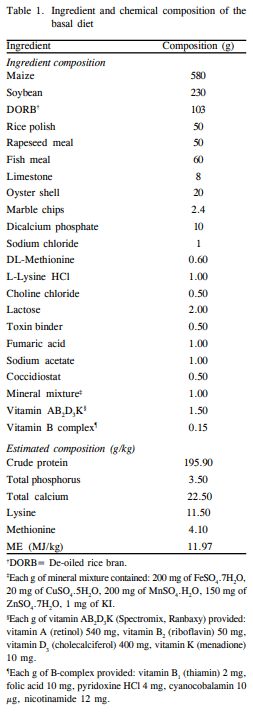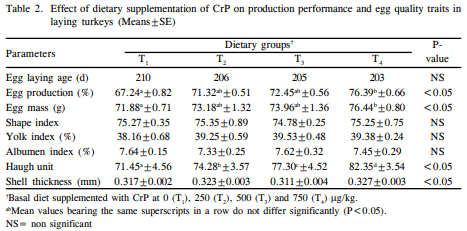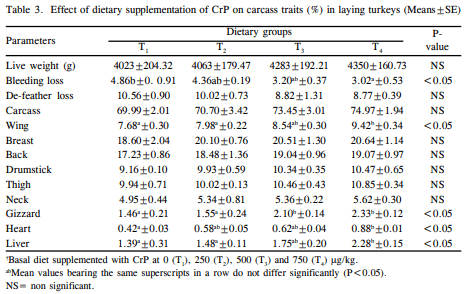Effect of Dietary Supplementation of Chromium Picolinate on Productive Performance, Egg Quality and Carcass Traits in Laying Turkeys
This experiment investigated the effects of dietary chromium picolinate (CrP) on production performance, egg quality traits and carcass traits of laying turkey. Seventy-two (72) female turkeys (16 wks old) were randomly distributed to four dietary treatment groups for a period of 24 weeks. Each treatment comprised three replicates, each containing 6 hens. Three experimental diets were supplemented with 250, 500 and 750 µg CrP/kg (T2 , T3 and T4 respectively) with basal diet and diet T1 was considered as control. All hens were provided feed and water ad libitum. Production performance in terms of age at sexual maturity did not differ significantly (P>0.05), whereas egg production and egg mass differ significantly (P<0.05) in T4 group compared to control and the two CrP treated groups (T2 and T3 ). Egg quality traits in terms of shape index, albumin index and yolk index did not differ significantly (P>0.05), whereas the Haugh unit score and shell thickness were significantly higher (P<0.05) in T4 treated groups than the control (T1 ) and other two treatment groups (T2 and T3 ). Percentage of carcass traits did not differ significantly (P<0.05) except the percentage of bleeding loss, wings and giblets among the control and CrP treated groups. From this study, it can be concluded that higher levels of dietary CrP (750 µg CrP/ kg diet) may be beneficial for production performance (egg production and egg mass), some egg quality traits (Haugh unit score and shell thickness) in laying turkeys whereas, no significant differences were observed in percentage of carcass traits except the percentage of bleeding loss, wings and giblets.
Key words: Carcass trait, Chromium picolinate, Egg quality trait, Performance, Turkey.



Amoikon, E.K., Fernandez, J.M., Souther, L.L., Thompson, D.L., Ward, T.L. and Olcott, B.M. 1995. Effect of chromium tripicolinate on growth, glucose-tolerance, insulin sensitivity, plasma metabolites, and growth-hormone in pigs. Journal of Animal Science, 73: 1123-1130.
Anderson, R.A. 1994. Stress effects on chromium nutrition of humans and farm animals. In: Biotechnology in the Feed Industry (Eds. T.P. Lyons and K.A. Jacques), University Press, Nottingham, UK, pp. 267-274.
Balk, E.M., Tatsioni, A., Lichtenstejn, A.H., Lau, J. and Pittas, A.G. 2007. Effect of chromium supplementation on glucose metabolism and lipids. Diabetes Care, 30: 2154-2163.
Colgan, M. 1993. Chromium boosts insulin efficiency. In: Optimum Sports Nutrition. Advanced Research Press, New York, pp. 313-320.
Debski, B., Zalewski, W., Gralak, M.A. and Kolsa, T. 2004. Chromium-yeast supplementation of chicken broilers in an industrial farming system. Journal of Trace Element Medical Biology, 18: 47-51.
Duncan, B.D. 1955. Multiple range and multiple F tests. Biometrics, 11: 1-12.
Eseceli, H., Degirmencioglu, N. and Bilgic, M. 2010. The effect of inclusion of chromium yeast (CoFactor II, Alltech Inc.) and folic acid to the rations of laying hens on performance, egg quality, egg yolk cholesterol, folic acid and chromium levels. Journal of Animal Veterinary Advance, 9: 384-391.
Funk, E.M. 1948. The relation of the yolk index determined after separating the yolk from albumen. Poultry Science, 27: 367.
Gallaher, D.D., Csallany, A.S., Shoeman, D.W. and Olson, J.M. 1993. Diabetes increases excretion of urinary malondehyde conjugates in rats. Lipids, 28: 663-666.
Haugh, R.R. 1937. The Haugh unit for measuring egg quality. US Egg and Poultry Magazine, 43: 552-555.
Heiman, V. and Carver, J.S. 1936. Albumen index as a physical measurement of observed egg quality. Poultry Science, 15: 141-148.
Hossain, S.M. 1998. Organic chromium in poultry: Metabolic responses, effects on broiler carcass composition, nutrient composition of eggs. In: Biotechnology in the Feed Industry (Eds. T.P. Lyons and K.A. Jacques). Nottingham University Press, Nottingham, UK, pp. 203-216.
Jackson, A.R., Powell, S., Johnston, S., Shelton, J.L., Bidner, T.D., Valdez, F.R. and Southern, L.L. 2008. The effect of chromium propionate on growth performance and carcass traits in broilers. Journal of Applied Poultry Research, 17: 476-481.
Kim, Y.H., Han, I.K., Choi, Y.J., Shin, I.S., Chae, B.J. and Kang, T.H. 1996. Effect of dietary levels of chromium picolinate on growth performance, carcass quality, and serum traits in broiler chicks. Asian-Australas Journal of Animal Science, 9: 341-347.
Kondaiah, N., Panda, B. and Singh, R.A. 1983. Internal egg quality measure for quail eggs. Indian Journal of Animal Science, 53: 1261-1264.
Lee, D.N., Wu, F.Y., Cheng, Y.H., Lin, R.S. and Wu, P.C. 2003. Effects of dietary chromium picolinate supplementation on growth performance and immune responses of broilers. AsianAustralasian Journal of Animal Science, 16: 227-233.
Lien, T.F., Horn, Y.M. and Yang, K.H. 1999. Performance, serum characteristics, carcass traits and lipid metabolism of broilers as affected by supplement of chromium picolinate. British Poultry Science, 40: 357-363.
Lindeman, M.D. 1996. Organic chromium - the missing link in farm animal nutrition. In: Biotechnology in the Feed Industry: Proceedings of Alltech’s Twelfth Annual Symposium (Eds. T.P., Lyons and K.A., Jacques). Nottingham University Press, Nottingham, UK, pp. 299-314.
Lindemann, M.D., Wood, C.M., Harper, A.F., Kornegay, E.T. and Anderson, R.A. 1995. Dietary chromium picolinate additions improve gain/feed and carcass characteristic in growing-finishing pigs and increase litter size in reproducing sows. Journal of Animal Science, 7: 457-465.
Linder, M.C. 1991. Nutrition and metabolism of the trace elements. In: Nutritional Biochemistry and Metabolism with Clinical Applications (Ed. M.C. Linder), Elsevier, New York, pp. 215-276.
NRC 1997. The Role of Chromium in Animal Nutrition. National Academy Press, Washington, DC.
Piva, A., Meola, E., Gatta, P.P., Blagi, G.C., Mordenti, A.L., Luchansky, J.B., Silva, S. and Mordenti, A. 2003. The effect of dietary supplementation with trivalent chromium on production performance of laying hens and the chromium content in the yolk. Animal Feed Science Technology, 106: 149-163.
Preuss, H.G., Grojec, P.L., Lieberman, S. and Anderson, R.A. 1997. Effects of different chromium compounds on blood pressure and lipid peroxidation in spontaneously hypertensive rats. Clinical Nephrology, 4: 325-330.
Sahin, K., Kucuk, O., Sahin, N. and Ozbey, O. 2001. Effects of dietary chromium picolinate supplementation on egg production, egg quality, and serum concentrations of insulin, corticostrerone and some metabolites of Japanese quails. Nutrition Research, 21: 1315-1321.
Sahin, K., Sahin, N., Onderci, M., Gursu, F. and Cikim, G. 2002. Optimal dietary concentration of chromium for alleviating the effect of heat stress on growth, carcass qualities, and some serum metabolites of broiler chickens. Biological Trace Element Research, 89: 53-64.
Seaborn, C.D., Cheng, N., Adeleye, B., Owens, F. and Stoecker, B.J. 1994. Chromium and chronic ascorbic acid depletion effects on tissue ascorbate, manganese, and 14C retention from 14Cascorbate in guinea pigs. Biological Trace Element Research, 41: 279-294.
Singh, R.P. and Panda, B. 1987. Effect of seasons on physical quality and component yields of eggs. Indian Journal of Animal Science, 57: 50-55.
Snedecor, G.W. and Cochran, G.W. 1985. Statistical Methods, 8th ed. The Iowa State University Press, Iowa, U.S.A.
Uyanik, F., Kaya, S., Kolsuz, A.H., Eren, M. and Sahin, N. 2002. The effect of chromium supplementation on egg production, egg quality and some serum parameters in laying hens. Turkish Journal of Veterinary and Animal Science, 26: 379-387.
Yildiz, A.O., Parlat, S.S. and Yazgan, O. 2004. The effects of organic chromium supplementation on production traits and some serum parameters of laying quails. Revue Medical Veterinary, 155: 642-646.










.jpg&w=3840&q=75)